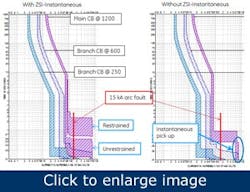ZSI can enable selective tripping
System reliability without compromising protection of circuits, equipment, and the people around them has always been the circuit breaker’s primary mission. Providing appropriate protection of the conductors, while preserving selective coordination, has been the primary focus for most system designers. However, the performance that was acceptable in the past may no longer be good enough.
Modern economic reality coupled with growing regulatory requirements demand optimal system performance with increased sensitivity to the inherent power system hazards that face operating and maintenance personnel. From a protection standpoint, reducing arc flash hazard should be a primary concern in modern power system design. Safety organizations, local authorities, and owner-operators demand better personnel protection and state-of-the-art capabilities to minimize hazards while simultaneously preserving power flow to critical loads as reliably as possible. Often, these requirements seem to be, and sometimes are, in conflict, pitting the speed and sensitivity required to improve arc flash protection against the timing and deliberate decision making required to maximize power system reliability and uptime.
Traditionally, selective coordination requires setting the pickup on the upstream breaker above the available fault current or slower than the clearing time of downstream devices. This forces upstream protective devices to be increasingly slower or less sensitive. To reduce arc flash hazard to a minimum and increase safety, the instantaneous pickup on all breakers must be lower than the expected arcing current in the respective protected circuit. The dilemma is that both these important needs conflict, therefore making it difficult to have both needs met simultaneously. Clearly, there is a need for technology that is able to provide significant flexibility toward solving arc flash hazard problems without excessive sacrifice of system reliability, in terms of selectivity.
Two forms of technology have been developed — waveform recognition (WFR) instantaneous tripping and instantaneous zone-selective interlocking (I-ZSI).
Waveform recognition technology allows the instantaneous pickup to go from traditional peak sensing to fault waveform dependent. The waveform recognition algorithm is a proxy for energy measurement that allows the trip to differentiate a true fault current from the high but limited let-through current allowed by a fast downstream protector such as a current-limiting fuse or circuit breaker. Used above current limiting circuit breakers or fuses, the WFR algorithm allows a sensitive pickup and fast tripping simultaneously. This provides arc flash hazard protection while providing maximum selectivity simultaneously. No compromise between the two is required.
Larger, non-current limiting breakers take longer than half a cycle to interrupt, so WFR is not effective in those cases.
The way ZSI works is downstream breakers that sense fault current signal the upstream breakers to let them know they are sensing and reacting to the fault current. This way, the breaker closest to the fault is the only one that clears and the other breakers act as backup just in case. Selectivity and reliability are thus achieved simultaneously. ZSI has existed in ground fault and short-time protection for many years allowing upstream breakers that would otherwise have been set to operate very slowly to have shorter delays for ground fault and short time. Now the timing improvement can be extended all the way to instantaneous. When combined with the lower pickup settings that WFR allowed the system’s circuit breakers to have, it is now possible to have sensitive instantaneous pickups and instantaneous clearing up and down the system with no loss in selectivity.
I-ZSI has two modes of operation: restrained and unrestrained. The unrestrained mode is the protective setting that provides protection when the fault is in the breaker’s zone of protection. In the case where downstream breaker interlocked CB senses the fault, the time-current-curve of the upstream breaker moves into the restrained time delay, which is the selective timing. With the restrained mode the upstream breaker is selective with feeder breakers but still aligned closely so backup protection can be provided in the case that the downstream breaker does not clear the fault.
Figure 1 assumes a simple system with three circuit breakers — a downstream current limiting branch circuit breaker as may be found in a panel or MCC; an upstream feeder within a switchboard or switchgear that feeds the panel or MCC; and the main breaker within that switchboard or switchgear. The image on the left shows the three devices in their protective operating timing, and the one on the right shows the main breaker shifted into its slower restrained operating short time and instantaneous band because the feeder CB sensed a fault in its zone of protection above the branch breaker. Selectivity between the feeder and the branch is provided by the waveform algorithm so the slight curve overlap is of no consequence. On top of both drawings is a red line that shows the 85% arcing current that the IEEE arc flash equations could predict. As the diagram on the left shows the instantaneous pickup on all the CB is sensitive enough to sense and react to the 16kA arcing current. Regardless which circuit breaker’s zone of protection becomes faulted the right CB will operate instantaneously every time.

